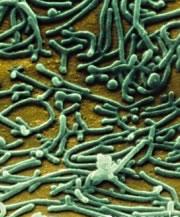 Mycoplasma bacteria have some of the smallest-known genomes.DON FAWCETT / SCIENCE PHOTO LIBRARY
Mycoplasma bacteria have some of the smallest-known genomes.DON FAWCETT / SCIENCE PHOTO LIBRARYBy transplanting their genomes, US scientists have converted one species into another.
John Glass and his co-workers at the J. Craig Venter Institute in Rockville, Maryland, have taken DNA from a bacterium called Mycoplasma mycoides and inserted it into cells of the closely related species Mycoplasma capricolum.
They find that the recipient cells with the new genome behave like those of the donor species, making protein molecules characteristic of the donor. It's like re-booting a cell with a new operating system, says Glass.
"The method is very impressive," says biomedical engineer Jim Collins of Boston University. "It's surprising that they could get such a large piece of DNA into the bugs, and even more surprising that they could get the new genome jump-started."
To swap the genomes, the researchers encased M. mycoides cells in a gel and used enzymes to break them apart and destroy their proteins, leaving only their naked DNA.
They mixed this DNA into colonies of M. capricolum and added a chemical that makes cells fuse together. The researchers suspect that some of the recipient cells fused around the naked donor genomes, producing cells with both species' DNA.
When these hybrids divide, one genome ends up in each daughter cell. The donor M. mycoides genome contained a gene conferring resistance to a specific antibiotic, a dose of which was used to kill off all the cells without the donor genome.
The two species' genomes are only about 75% identical. So it wasn't obvious that M. capricolum 's machinery for reading and acting on genetic instructions would also work for M. mycoides.
Minimal genome
The work raises the possibility of reprogramming cells with new functions — perhaps even turning cells from other organisms into human stem cells for regenerative medical treatments.
But that is a long way off. Glass's team currently has its sights set on giving a bacterium a completely synthetic genome, made in the laboratory.
This would enable the researchers to design a new species from scratch. It is an ambitious aim, not least because the design rules for an entirely artificial genome are still poorly understood. But the latest work, reported in Science1, shows that a cell's molecular machinery can run on a different genetic operating system.
The bacteria used in the study have very small genomes. Both are pathogens that live in goats, but the team is looking at a related species, Mycoplasma genitalium, a parasite of the human genital tract, as a candidate for making a minimal genome.
The researchers hope to find the smallest set of genes capable of supporting life. They have applied for a patent on a subset of 381 of M. genitalium 's 485 genes (see 'The patent threat to designer biology').
ADVERTISEMENT
Such a minimal genome could be the chassis of a general-purpose cell, to which genes for tailored functions, such as generating pharmaceuticals or biofuels, could be added.
Genome transplants, say the researchers, could make cells that are "platforms for the production of new species using modified natural genomes or manmade genomes". Collins says he expects the team to test their minimal genome by putting it into Mycoplasma. "The question is, can they get it jump-started?" he says.
Visit our transplantmakes_specie.html">newsblog to read and post comments about this story.
